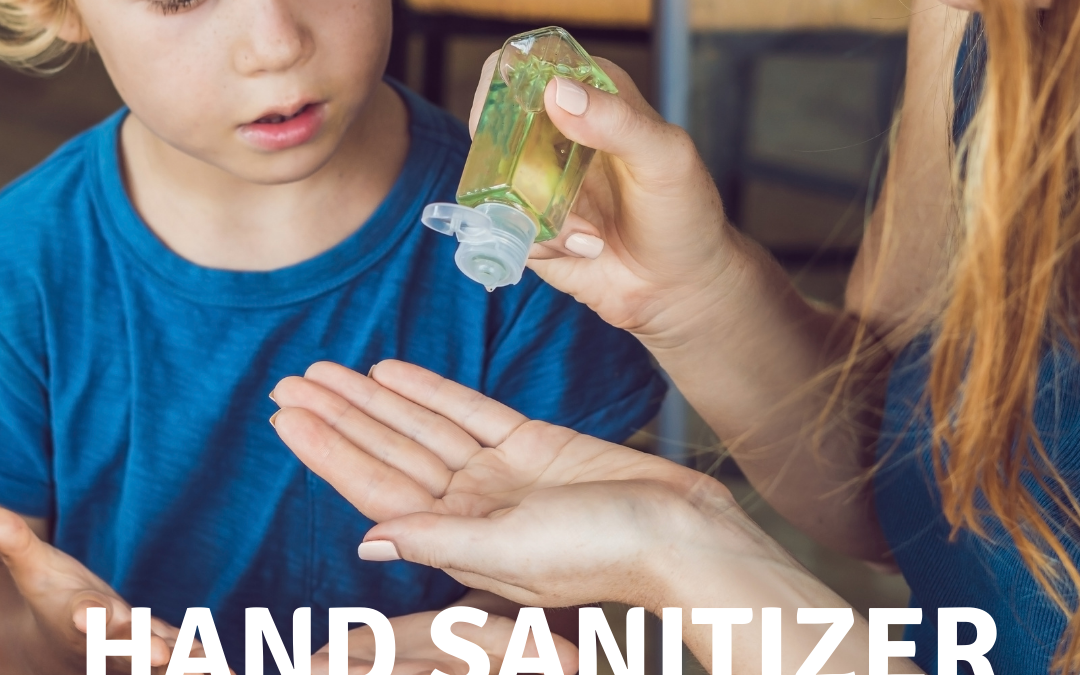Hand Sanitizer Safety – What You Need to Know
In addition to Covid, ‘tis the season of coughs and sneezes and stomach bugs. This year more than years past, people are really serious about germs, however! Hand sanitizer is everywhere! Every counter, desk, produce aisle, doctor’s office, classroom, bathroom… even suspended by cute hang tags on handbags and backpacks. While hand sanitizer safety may not be something that has even crossed your mind, there are things that you need to know.
Six months ago, people were happy to get any bottle of Plain Jane sanitizer. However, the market is again ripe with designer scents, glittery and colorful options.
Hand sanitizer is mainstream, so it must be safe… right?
Covid19 Defense
I’m a holistic health professional in addition to being a mom. As a result, I safety check everything that gets close to my tribe. This year, hand sanitizer was not just something on the back to school supply list. It’s EVERYWHERE because we know that it is a solid defense against Covid-19. The CDC reports that hand sanitizers with a minimum 60% alcohol content are an effective defense when handwashing with soap is not available.
Though hand sanitizer is a part of daily life now, there are things that you really need to know about it’s safety!
The FDA and Safety Data
The FDA’s most recent review in April 2019 found only 3 ingredients being evaluated as potential for safe long-term use. Janet Woodcock, M.D., director of the FDA’s Center for Drug Evaluation and Research stated
“In today’s final regulation we finalized the FDA’s previous determination that 28 active ingredients, including triclosan and benzethonium chloride, are not eligible for evaluation under the FDA’s OTC Drug Review for use in consumer antiseptic rubs. We’ve also reaffirmed our need for more data on three other active ingredients, including ethyl alcohol, which is the most commonly used ingredient in hand sanitizers, to help the agency ensure that these products are safe and effective for regular use by consumers.”
So, the question is: what do we as consumers and daily users of hand sanitizer need to know:
Questionable Chemicals
- Scent/fragrance: Companies are not required to disclose the ingredients that make up their secret scents. Synthetic fragrances contain phthalates. Phthalates are endocrine disruptors that mimic hormones and can impact reproductive health.
- Parabens: These are preservatives that extend shelf life. The problem is, they can shorten yours. Parabens have estrogenic qualities and have been found in breast tumors.
- Other (inactive) ingredients include benzophenone-4, carbomer, glycerin, isopropyl myristate, propylene glycol, and tocopheryl acetate. Some of these ingredients are harmless, while others are toxic.
Alcohol Content
- Hand sanitizers are mostly alcohol, which is drying to the skin and can be harmful if ingested.
- Ingestion is especially hazardous for children. Here’s one headline that grabbed me: “More children getting drunk on hand sanitizer.“
The Danger of Ingestion
- In Georgia, a 6 year old who ingested hand sanitizer while at school needed to be admitted to the hospital, because she was dangerously drunk. 3 or 4 squirts of hand sanitizer spiked her blood-alcohol level to .179 – That is twice what’s considered legally drunk for an adult. The amount of alcohol in hand sanitizer ranges from 45% to 95%. Ingesting even small amounts — as little as two or three squirts, can cause alcohol poisoning. By comparison, wine and beer contain about 12% and 5% alcohol.
- Each year between 2011 and 2015, the American Association of Poison Control Centers noted that there were over 17,000 hand sanitizer exposure cases in children under 12 years old. The data for 2020 is much higher. As of October 31, 2020, poison control centers have managed 20,676 exposure cases in the under 12 age group.
Exposure doesn’t necessarily mean poisoning. However, it does mean is that there was contact with the substance that resulted in a visit to a medical professional.
Challenges
Let’s consider the challenges that hand sanitizer presents in the 3 age groups most at risk:
- In younger children, it’s more common for ingestion to be a bit of an experiment because of the glittery look of the gel or kid-friendly smells like berry, lemon and melon.
- Looking at the poisoning cases in the 7-12 year olds, what’s startling is that many are NOT accidental. These poisonings are the result of children drinking the hand sanitizer intentionally in order to get drunk.
- Similarly, in teens, covert chemistry and distillation can spell disaster – and you bet it happens.
What you need to know:
- First, a child who licks a tiny amount of hand sanitizer off of his/her hands is unlikely to become sick.
Just a lick = unlikely to get sick. - However, a child who ingests more than a taste of hand sanitizer could be at risk for alcohol poisoning.
Significant ingestion = you need to question. - A pocket-sized bottle of hand sanitizer is the equivalent of 2-3 shots of hard liquor.
- Alcohol content in hand sanitizer ranges from 40% to 95%.
- Popular hand sanitizers (and those effective against Covid19) contain 60-70% ethyl alcohol. That is the equivalent of 120 proof and is a stronger alcohol concentration than most hard liquors. For comparison, wine contains about 10-15% and beer contains about 5-10% alcohol. The remaining alcohol is most often isopropyl alcohol, which is toxic when ingested.
- Symptoms of alcohol poisoning include confusion, vomiting and drowsiness and, in severe cases, respiratory arrest and death.
Action Steps for Safety:
- Choose hand-washing with soap and water when you can. Experts affirm that hand-washing is superior protection against Covid and other illnesses.
- Purchase a hand sanitizer that is free of unnecessary ingredients and harmful phthalates and parabens. These two are rated best by the Environmental Working Group:
- Keep hand sanitizer out of reach of children and monitor its use.
- Apply a dime-sized amount to dry hands and rub hands together until they are completely dry.
- Call the Poison Control Helpline at 1-800-222-1222 immediately if you suspect your child has ingested hand sanitizer. Do not wait for symptoms to develop. Above all, the hotline is staffed 24 hours a day, seven days a week, every day of the year for poisoning emergencies and informational calls.
While keeping your hands clean and germ free is important in the fight against Covid 19, eating healthy and supporting your immune system is also important. My next post will outline a few simple steps you can take to cover your bases. Sign up for my newsletter below and follow me on Facebook, Instagram and Twitter so you stay informed and get access to new content, recipes and freebies!
BONUS Super Soap Recipe
Soap and water is still the preferred method for germ fighting. In addition, the CDC notes that hand-washing is preferred to using hand sanitizer as a Covid19 defense. The great thing is that hand washing is easy and something you already do! Whether you’re cooking in your kitchen, using the bathroom or cleaning up after an activity or before eating, keep up the good work! Consider shifting from your current soap to the one here (or one like it).
What you need:
- 8 ounce Foaming soap pump dispenser (wash and upcycle an old one)
- Castile soap (I love Dr. Bronner’s plain castile soap)
- Distilled water
- Therapeutic grade essential oils. (Thyme, clove, lemon or lavender are the best oils to use if you want to use only one oil; otherwise see list and great combo ideas below) (This is my source for wholesale pricing on therapeutic grade essential oils.)
Directions:
- First, fill a foaming soap bottle about ⅔ with distilled water.
- Then, add 3 Tablespoons of the castile soap.
- Next, add desired mix of essential oils (48 drops in 8 ounces of liquid makes a generally skin-safe 1% dilution; for a 2% dilution, use 96 drops. You would NOT want to use only hot oils like oregano, cinnamon or thyme because that could irritate skin).
- Finally, screw on the pump and gently turn the bottle upside down a few times to combine the mixture.
Essential oils with significant antibacterial effects*:
| Balsam Fir | (E.coli, Staph) |
| Chamomile/ Grapefruit | (Staph) |
| Cinnamon | (Diplococcus pneumoniae, Enterococci, E.Coli, Klebsiella, MRSA, Salmonella, Staph, Strep) |
| Clove | (Diplococcus pneumoniae, Enterobacter, Enterococci, E.Coli, Klebsiella, Mycobacterium tuberculosis, MRSA, Proteus, Salmonella, Staph, Strep) |
| Cypress | (E.Coli, Mycobacterium tuberculosis, MRSA, Staph, Strep) |
| Frankincense | (Bacillus subtilis, Klebsiella, Mycobacterium phlei, Sarcina, Staph) |
| Geranium | (Diplococcus pneumoniae, Enterobacter, Enterococci, Klebsiella, Proteus, Salmonella, Staph, Strep) |
| Helichrysum | (Enterobacter, E.Coli, Klebsiella, Staph) |
| Lavender | (Enterococci, E.Coli, Klebsiella, MRSA, Salmonella, Staph, Strep) |
| Lemon | (Diplococcus pneumoniae, Enterococci, Mycobacterium tuberculosis, MRSA, Staph, Strep) |
| Lemongrass | (MRSA, Staph) |
| Neroli | (Enterococci, E.Coli, Klebsiella, Klebsiella, Strep) |
| Oregano | (E.Coli, MRSA, Salmonella, Staph, Strep) |
| Peppermint | (E.coli, Klebsiella, MRSA, Proteus, Salmonella, Staph, Strep) |
| Petitgrain | (Diplococcus pneumoniae, Enterococci, H.Pylori, Staph, Strep) |
| Rosemary | (Enterobacter, E.Coli, Klebsiella, MRSA) |
| Tea Tree | (Enterococci, E.Coli, MRSA, Proteus, Salmonella, Staph, Strep) |
| Thyme | (Diplococcus pneumoniae, Enterococci, E.Coli, Klebsiella, MRSA, Salmonella, Staph, Strep) |
These are winning combinations:
| Warming: | Neroli, Clove and Cinnamon |
| Fresh: | Lemon or Grapefruit and Peppermint |
| Everyday: | Lavender, Lemon and Balsam Fir |
| Germ Warfare: | Cinnamon, Clove, Frankincense, Tea Tree, Oregano, Thyme, Lemon |
| Sweet: | Roman Chamomile and Lavender |
| Floral: | Geranium and Lemongrass |
*While essential oils are beautiful allies for health, they are NOT effective at killing Covid19. They are effective against some pathogens and benefit health and well-being as aromatherapy. DIY hand sanitizer is NOT recommended as protection against Covid19. It is important to continue with proper hand washing. When using hand sanitizer choose one with at least 60% alcohol.
Safety Note
Always check with your trusted medical provider if you have questions or concerns about your health or about choices related to your health.
Resources:
- http://www.aapcc.org/alerts/hand-sanitizer/
- http://abcnews.go.com/blogs/headlines/2012/04/teens-getting-drunk-on-hand-sanitizer/
- http://chemistry.about.com/od/toxicchemicals/a/Can-You-Drink-Hand-Sanitizer.htm
- https://www.health.harvard.edu/press_releases/proper-hand-washing – Harvard Health
- Price, Shirley. Aromatherapy for Health Professionals. Fourth Edition. Elsevier 2012
- Tisserand & Young, Essential Oil Safety: A Guide for Health Care Professionals-, 2e. Churchill Livingstone; 2013

